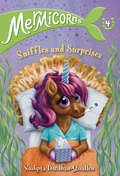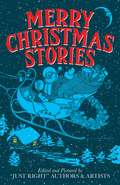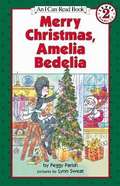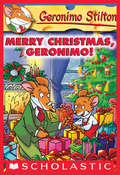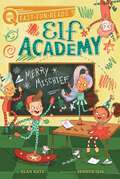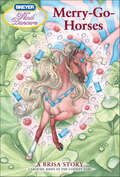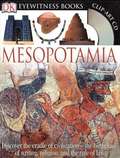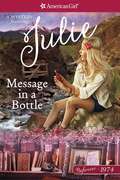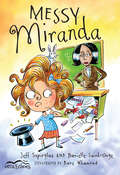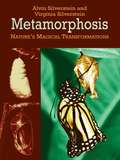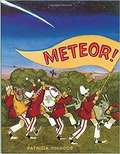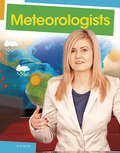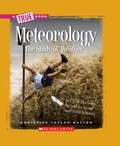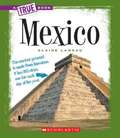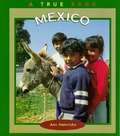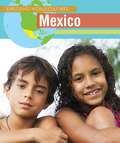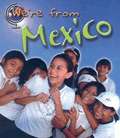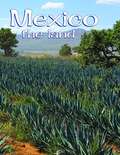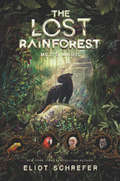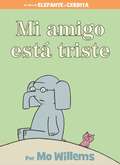- Table View
- List View
Mermicorns #4: Sniffles and Surprises (Mermicorns #4)
by Sudipta Bardhan-QuallenPart unicorn, part mermaid, and totally magical! Don't miss this exciting chapter book series from the author of the popular Purrmaids series!Oh no! Lily is sick. That means she&’s stuck in bed all day. She&’s going to miss an exciting lesson at the Magic Academy. Even worse, she can&’t go to the clubhouse after school with her best friend, Sirena. Is her whole day ruined? Or do Sirena and their kitten friends have a surprise for her? Read all the Mermicorn adventures:#1: Sparkle Magic#2: A Friendship Problem#3: The Invisible Mix-Up
Merry Christmas Stories
by "Just Right" Authors and ArtistsPerfect for reading aloud, this charming collection of holiday tales is the ideal companion for anyone who wants to celebrate an old-fashioned Christmas. Fifteen seasonal stories begin with the Clement Clarke Moore classic, "The Night Before Christmas," which sets the mood for other lesser-known gems that recount tales of adventure, surprise, humor, and goodwill. Heartwarming illustrations from the 1926 edition complement "The Christmas Tree that Went Walking," "Why the Top Sings," "The Star Angel," "Old Mother Bear's Christmas Stocking," "The Story of Baby Gretel," and other vintage stories of Yuletide cheer.
Merry Christmas, Amelia Bedelia (I Can Read Level 2 Ser.)
by Peggy Parish Lynn SweatIt's almost time to look for Santa Clause, and it's always time to look for fun with Amelia Bedelia.
Merry Christmas, Annie
by Dana BergmanAfter eleven years at an orphanage, Annie longs for a family to call her own. So when the wealthy Oliver Warbucks invites Annie to spend the Christmas holiday at his New York mansion, it's a dream come true. Could it be that Mr. Warbucks is the family she's waited for all along?<P><P> Fifty million people of all ages have been delighted by stage and screen productions of Annie, and now some of the youngest fans can enjoy the story of everyone's favorite little orphan as she experiences Christmas like never before!
Merry Christmas, Geronimo!: Merry Christmas, Geronimo! (Geronimo Stilton #12)
by Geronimo StiltonEnter the world of Geronimo Stilton, where another funny adventure is always right around the corner. Each book is a fast-paced adventure with lively art and a unique format kids 7-10 will love.I was so excited about Christmas, I could squeak! My favorite nephew Benjamin was going to come over, and we were planning to trim the tree and eat lots of delicious holiday Cheesy Chews. But before you could say "cat alert," disaster struck! I slipped over my tail and ended up in the hospital. And then my mouse hole caught on fire! Holey cheese, this was turning out to be the worst Christmas ever....
Merry Mischief: A QUIX Book (Elf Academy #4)
by Alan KatzThe Elf Academy elves take on babysitting in this fourth and final book in a series about a young elf&’s merry misadventures, part of the Aladdin QUIX line of fun-to-read, short chapter books that&’s perfect for emerging readers!Andy Snowden has to take care of his teacher&’s niece and nephew who are moving to the North Pole. Has he finally met his mischievous match?
Merry-Go-Horses: A Brisa Story (Wind Dancers)
by Sibley MillerThe Wind Dancers—Kona, Brisa, Sumatra, and Sirocco—are back with four more full-color illustrated titles sure to delight the imaginations of horse-loving little girls everywhere.When the Wind Dancers find themselves at a county fair, they are enchanted by everything there is to see (from the show jumping horses to the English pleasure rides) and do (riding horses that, astonishingly, look just like them). Carousel rides, anyone?
Merry-Go-Rounds
by Art Thomas George OverlieThis text presents the history of merry-go-rounds which had their beginning in Arabia more than nine hundred years ago.
Mesopotamia (DK Eyewitness Books Ser.)
by Philip Steele Dorling Kindersley Publishing Staff John FarndonTravel back to the land where human history was first recorded—the land of kings, queens, gods, goddesses, nomads, and scribes. Be an eyewitness to the "land between the rivers," from the first Sumerian city-states to the mighty Babylonian empires. Featuring a pull-out wall chart and its own clip-art CD, Mesopotamia provides a detailed look at where the first cities, states, and empires rose. Richly detailed full-color images and photographs of ancient artifacts, architecture, and maps combine with a comprehensive overview of the Sumerian, Assyrian, and Babylonian civilizations. See incredible works of Mesopotamian art, meet the warriors and innovators living ahead of their time, learn how to read ancient inscriptions, and much, much more!
Message in a Bottle: A Julie Mystery (American Girls Mysteries)
by Kathryn ReissWhen Julie visits Gold Moon Ranch, a farming commune in California's gold rush country, the back-to-the-land lifestyle seems idyllic at first. But peculiar problems keep cropping up - almost as if someone was trying to shut down the commune! Then, on a secret trip to an abandoned gold mine, Julie stumbles on a mysterious message that hints at long-lost treasure. Julie is desperate to find it - before danger closes in on Gold Moon Ranch.
Messi, Superstar: His Records, His Life, His Epic Awesomeness
by Jon Stollberg Duopress Labs StaffMillions of kids around the world know Lionel Messi, and they all know he is really good. But do they know how good he really is? To answer this question, this engaging book goes beyond a traditional biography and describes Messi's life and record-breaking career through the use of fun graphics, comparisons with past and present players, playful reader challenges, and pages chock-full of interesting facts.<P><P> <i>Advisory: Bookshare has learned that this book offers only partial accessibility. We have kept it in the collection because it is useful for some of our members. To explore further access options with us, please contact us through the Book Quality link on the right sidebar. Benetech is actively working on projects to improve accessibility issues such as these. </i>
Messy Miranda (Orca Echoes)
by Danielle Saint-Onge Jeff SzpirglasMiranda has one messy desk. It's full of books, pencils, science projects and…other stuff. Too much stuff, says her teacher, Ms. Basil. On a family visit to her Uncle Aldo's one night, Miranda wonders if some of his magician's tools might offer a solution to her messy-desk problem. Sneaking off to the magic room, Miranda finds Uncle Aldo's impressive collection of top hats. Miranda knows that magic top hats can hold lots of things—why not the mess from her desk? At first, the hat seems to do the trick, but soon things start to go horribly wrong. As Uncle Aldo says, you have to be careful with magic. The epub edition of this title is fully accessible.
Metamorphosis: Nature's Magical Transformations (Dover Children's Science Bks.)
by Alvin Silverstein Virginia SilversteinWith this easy-to-read book, children will discover the facts behind the seemingly magical conversions that transform a wooly caterpillar into a graceful butterfly and a swimming tadpole into a leaping frog. This book presents a well-illustrated look at how some baby animals develop from a larval stage into a completely different creature.
Meteor!
by Patricia PolaccoThe meteor that crash landed in Grandma and Grandpa Gaw's yard set off a chain of gossip and events that brought magic to many of the residents of Mudsock Meadow. This book is based on a true event, and the author's sometimes far-fetched imaginings are at once believable and amusing.
Meteorologists (Jobs People Do)
by Emily RaijWhat will the weather be like tomorrow? Meteorologists forecast the weather, but they have other jobs behind the scenes. Readers will learn about how meteorologists study the weather, the tools they use, and how people get this exciting, fast-paced job.
Meteorology: The Study Of Weather (New True Books: Space)
by Christine Taylor-ButlerA True Book: Earth Science series presents fascinating facts and fun activities that will engage the budding earth scientist, while exploring the fields of geology, meteorology, ecology, and more. This series includes an age appropriate (grades 3-5) introduction to curriculum-relevant subjects and a robust resource section that encourages independent study. Readers will find out how meteorologists study patterns in Earth's atmosphere to predict temperature changes, dangerous storms, and even global climate change.
Meteoros (¡Arriba la Lectura!, Level M #24)
by Chantal Stewart Heather Hammonds¡Mira! ¡Ahí, arriba, en el cielo! ¡Es una nube de polvo! ¡Es un grupo de rocas! ¡Es un meteoro! Lee para saber todo acerca de cómo el polvo y las rocas que atraviesan la atmósfera a gran velocidad se combinan para crear fantásticos destellos de luz en el cielo nocturno. NIMAC-sourced textbook
Mexico (A True Book)
by Ann HeinrichsCompletely redesigned for today's young investigative reader, True Books are an indispensable addition to any collection. Each book guides readers through the facts that nurture their need to know.
Mexico (Exploring World Cultures Series)
by Ruth BjorklundMexico is a country with many unique traditions and people. This book describes what is like to live in Mexico, and gives insight into its history, beliefs, economy, environment, and geography. The book also includes photographs that correspond to the text to help readers better understand concepts.
Mexico (We're from)
by Victoria ParkerFind out what school and home life is like for children in Mexico. What is the capital city of Mexico? When does Luis go to school? Why does Raul sleep in a hammock.
Mexico: The Land (The Lands, Peoples, and Cultures Ser.)
by Bobbie KalmanBrilliant new photos highlight Mexico's deserts, plains, rainforests, and mountains in this newly revised edition. Mexico's agriculture, industries, overpopulation, and Mayan and Aztec roots are featured along with a new map and new information on free trade and immigration.
Mez's Magic (The Lost Rainforest #1)
by Eliot SchreferThe Lion King meets Wings of Fire in the magical rainforest kingdom of Caldera in this new middle grade animal fantasy series from New York Times bestselling author and National Book Award finalist Eliot Schrefer. Caldera has forever been divided into those animals who walk by night and those who walk by day. Nightwalker panthers, like young Mez and her beloved sister, have always feared daywalkers as creatures of myth and legend. Until the eclipse. Now Mez has discovered that she can cross the Veil and enter the daylight world. Her magical power has unknown depths, but she must rush to discover it after a mysterious stranger arrives at her family’s den, bearing warnings of a reawakened evil. Saving Caldera means Mez must leave her sister behind and unite an unlikely group of animal friends to unravel an ancient mystery and protect their rainforest home.
